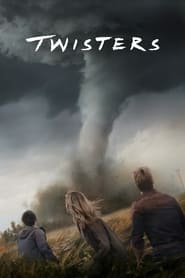— We got to get everyone to the movie theater!
You don't need to be an adept cultural commentator to make something from the renewed interest in a disaster franchise based on extremely dangerous and unpredictable climate phenomena. Indeed, perhaps to strike this point home, the first on-screen death is of a character whose appearance is symbolic of the Global South. Yet they don't call Hollywood the dream factory for nothing: something tells me we aren't going avoid catastrophic climate change by repurposing military technology and launching tons of microplastics and chemicals into the sky.
There is little otherwise of great interest. Quite a lot of it is rather obviously ripped from the headlines stuff, especially all the rather cursory YouTuber stuff. I guess streamers buy sneakers too. Ditto the obviously evil guy exploiting any disaster to pick up cheap real estate. There's always a grift somewhere in America. Given the emphasis on tracking and taking photos of the tornadoes, Twisters felt at times yet another movie about war photography. How many of these films do we need?
Still, it's always nice to have a film not based in California, Washington D.C. or New York, but something tells me that Oklahoma natives aren't especially going to recognise this picture of the Sooner State beyond the somewhat overused musical signifiers. What there is, however, is a good dose of schlock. Most of the time, the film keeps it in check, but there are moments where the tone feels a little close to The Mummy, especially with the British journalist playing the buffoon and Glen Powell doing a pretty good impression of late-90s Brendan Fraser. As in, when he isn't looking pretty the same as he did in The Hit Man (2023): was he wearing the exact same Billy Reid denim shirt?
One paradox in the film is how puritan it thinks it is. There is not even a kiss at the end, yet all of the actual tornado experience is obviously sexual, especially the sequence where they hide in the swimming pool. Another glaring contradiction is that despite all the obvious danger, it is remarkable just how little the deaths of humans figure in the movie's stakes. No doubt this is chiefly to court a '12' and PG-13 certificate, but the result is that the film's main concern (after a town has been levelled to the ground and hundreds have presumably been made homeless) is the damage to the real estate. In this time of political division, it is nice to see some American values are pretty much irradicable.
Incidentally, I thought it'd be rather droll to catch an 8:00am showing of this movie, and that was indeed an experience in itself. The staff were at least awake to enough to not bother trying to sell me popcorn; if anything, it was they who were jealous of my completely unconcealed hot coffee.
[A] jumble of poorly sketched backstories and subplots, half-hearted topical references (such as the climate crisis being quickly mentioned as a reason for the rise of dangerous tornado activity), and tepid fan service (a sequence set in a movie theater pales in comparison to the tornado ripping through the drive-in screen in the original).
— Mark Hanson (Slant Magazine)
I just wanted to make sure that with the movie, we don’t ever feel like (it) is putting forward any message…. I just don’t feel like films are meant to be message-oriented.
— Director Lee Isaac Chung (CNN)
Twisters, puzzlingly, can’t even be bothered to allow its two leads a satisfying kiss in its romantic conclusion. It’s a grand finale which informs the film’s overall lack of character and definition, aside from its storms and its Glen Powell.
— Brianna Zigler (Paste Magazine)
The YouTube segments feel forced into the proceedings to appeal to a younger crowd and get that four-quadrant appeal. Indeed, much about Twisters feels engineered rather than organic, resulting in a production that registers as safe and predictable instead of alive.
— Brian Eggert (Deep Focus Review)
This impersonal exaltation of heroic exploits leaves an unexplored dilemma at the foundation of the film. A key detail, in the traumatic opening sequence, raises questions about the ethics and the risks of scientific inquiry. When Kate, Javi, and their schoolmates manage to release a load of polymer up a tornado’s funnel, they notice that, instead of shrinking, the tornado grows. The scene introduces the harrowing possibility that the test has not only failed but has actively caused harm. Yet in the course of the movie Kate, for all her guilt over her friends’ death, never once considers that her approach to taming the tornado might actually have made her a Dr. Frankenstein of meteorology whose miscalculations created a more monstrous storm.
— Richard Brody (The New Yorker)
The book somebody read here is How to Blow Up a Pipeline, by which I mean they saw Daniel Goldhaber’s 2022 movie of it, which also features Sasha Lane in the cast, in the exact same role as of the rebel wranglers. A pipeline and a refinery do get blown up in Twisters, but these storm chasers have substituted politics for meteorology, ironic since the real Weathermen were bomb-making radicals.
— A. S. Hamrah (n+1 magazine)
Synopsis: As storm season intensifies, the paths of former storm chaser Kate Carter and reckless social-media superstar Tyler Owens collide when terrifying phenomena never seen before are unleashed. The pair and their competing teams find themselves squarely in the paths of multiple storm systems converging over central Oklahoma in the fight of their lives.

